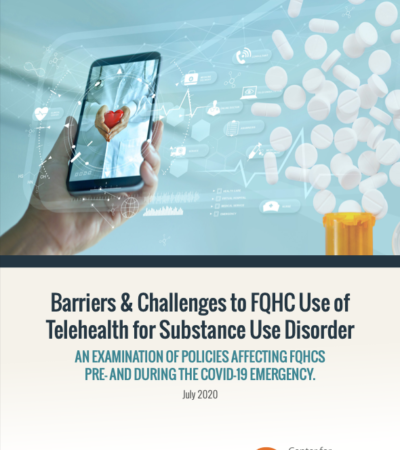FQHC Telehealth Resources
Barriers & Challenges to FQHC Use of Telehealth for Substance Use Disorder
With funding from the National Institute for Health Care Management Foundation (NIHCM), CCHP conducted a research study on policy changes that need to be made in order for federally qualified health centers (FQHCs) to utilize telehealth to address the opioid crisis.
With opioid overdose being classified by the Department of Health and Human Services (HHS) as a nationwide epidemic, and FQHCs often serving as the first line of defense in rural and underserved communities, many clinics are looking to telehealth to help address opioid use disorders (OUD) and deliver Medication Assisted Treatment (MAT), a best practice treatment for opioid addiction which combines medication and behavioral therapy. However, many FQHCs find themselves restricted from establishing a telehealth program to treat OUD given an array of unique and complex policy barriers, both on the federal and state policy levels.
The research for this study began in early 2020, and focused on five states with high incidents of OUD and where entities within the state had received funding for substance use disorder projects from the U.S. Health Resources Services Administration (HRSA). The five states selected included Kentucky, Maine, Maryland, Ohio and Pennsylvania. CCHP conducted key informant interviews with Medicaid representatives, FQHC staff and primary care provider associations, as well as conducted a thorough analysis of each states’ laws, regulations and Medicaid policies pertaining to the intersection of telehealth, OUD treatment and FQHC policy. The most significant barriers included Medicare and Medicaid prohibitive reimbursement rules as well as the difficulty of navigating prescribing laws and regulations on both the federal and state levels. When COVID-19 hit in mid-March and telehealth was the only way to keep patients safe at home while still accessing healthcare services, longstanding policy barriers were removed in a matter of days with subsequent revisions further expanding telehealth access following in the subsequent weeks. Therefore, CCHP conducted a secondary analysis on the policies that have impacted FQHCs’ ability to deliver MAT via telehealth during the COVID-19 PHE and beyond. Although many of the policy barriers originally identified in CCHP’s initial research and interviews have been temporarily resolved, their future remains uncertain. Some, including the allowance for the home to be an eligible originating site, as well as expansions in eligible providers (including FQHCs) and services are likely to remain in some form, while others are less so, such as relaxation of HIPAA requirements.
The issue brief provides a comparison of reimbursement and prescribing policies both prior to and following the onset of the COVID-19 emergency. It also provides a chart on when the policy is set to expire (as of the time of writing the issue brief) and what it would take to make each policy change permanent. Even with the expansions for telehealth made as a result of COVID-19, some barriers still remain for FQHCs delivering MAT services via telehealth, including the different rate FQHCs receive for delivering telehealth services compared to their normal PPS rate, as well as issues around broadband connectivity, patient and provider education, and liability coverage.
To learn more on the complex policy environment FQHCs must navigate to deliver MAT services via telehealth, read the full Issue Brief.

